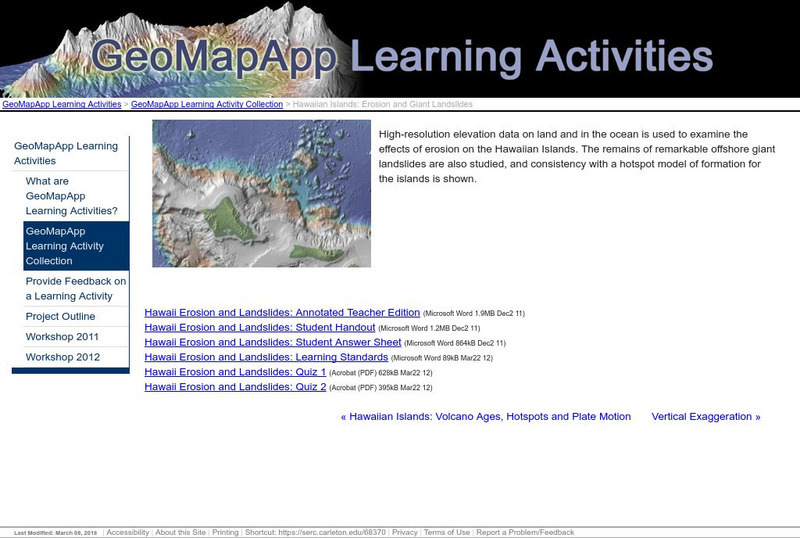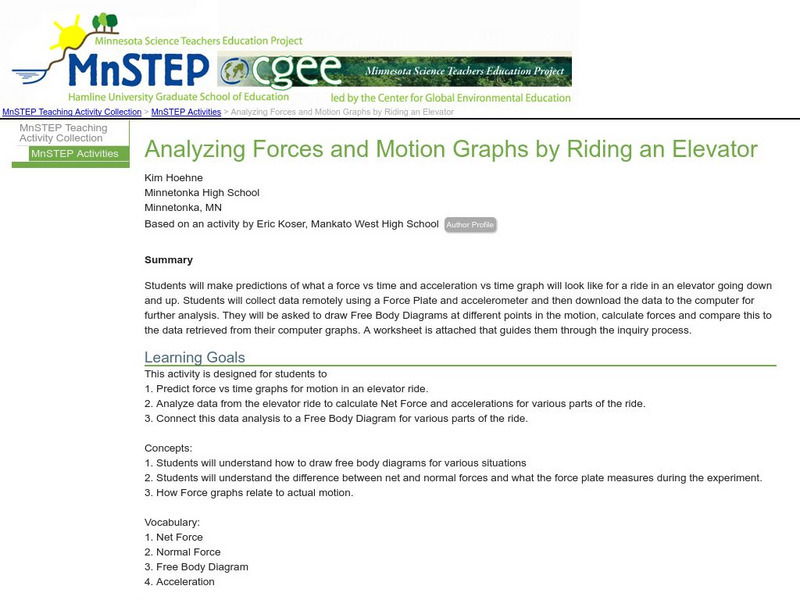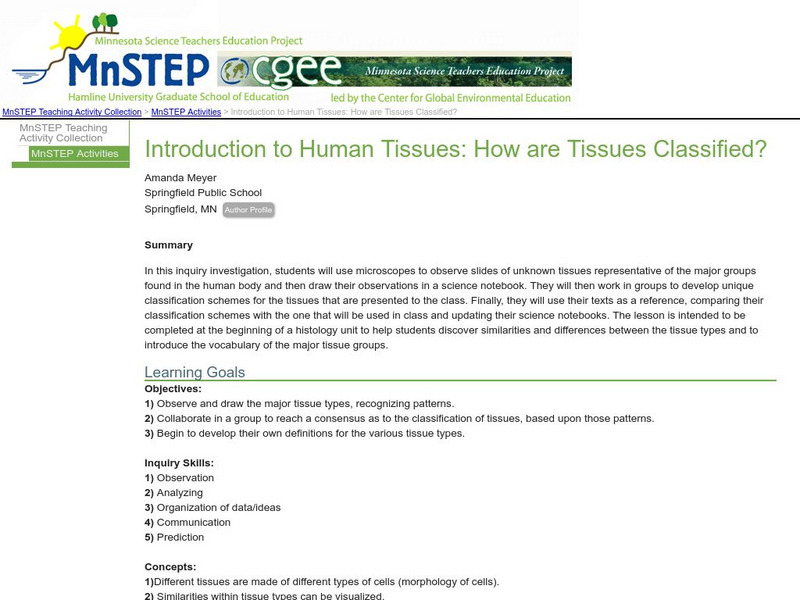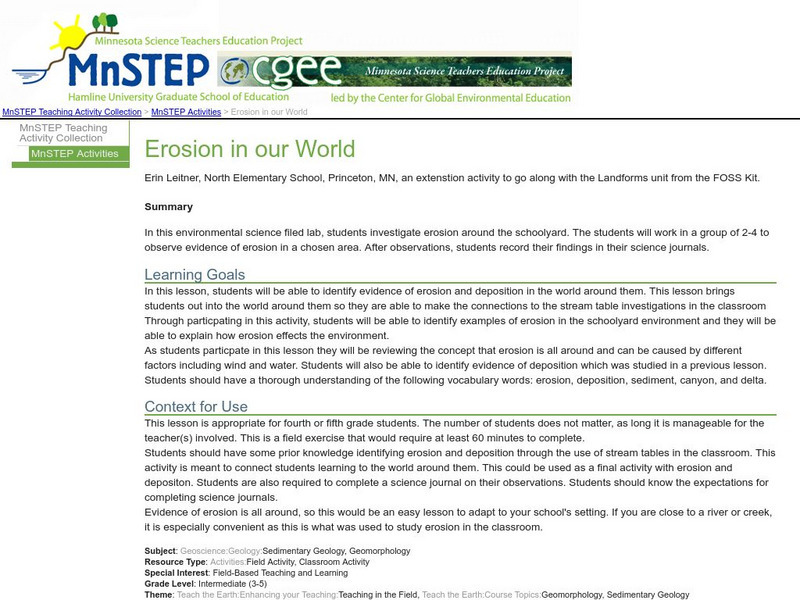Science Education Resource Center at Carleton College
Serc: Analyzing Plate Motion Using Earth Scope Gps Data
In this chapter, you will access Global Positioning System (GPS) data from the Plate Boundary Observatory (PBO) and analyze the data in a spreadsheet to measure the motion of GPS stations in the Pacific Northwest. From your analyses, you...
Science Education Resource Center at Carleton College
Serc: Hawaiian Islands: Erosion and Giant Landslides
High-resolution elevation data on land and in the ocean is used to examine the effects of erosion on the Hawaiian Islands. The remains of offshore landslides are also studied, and consistency with a hotspot model of formation for the...
Science Education Resource Center at Carleton College
Serc: Hotspot Lesson: Relative Dating
This lesson explains the application of relative dating for volcanic features in the ocean, after which students will identify which volcanic features are relatively older than others.
Science Education Resource Center at Carleton College
Serc: Lab 1: Getting to Know the Cryosphere
A lab experiment (in a series of experiments) that explores the cryosphere. In this lab, students will be introduced to the different parts of the cryosphere and their locations. They will also be shown the connections between the...
Science Education Resource Center at Carleton College
Serc: Lab 7: Nitrates and Phosphates and Algae, Oh My!
A lab experiment, in a series of experiments, that investigates fisheries. In this lab, students test the effects of fertilizers and other pollutants on a model ecosystem. Students also examine 2 years of ocean color (chlorophyll...
Science Education Resource Center at Carleton College
Serc: Extinction: Is It Inevitable?
Learners read the article "The Sixth Extinction" by Niles Eldredge on past mass extinctions and the current rate of loss of species. There is a choice of student activities which includes having students respond to discussion and...
Science Education Resource Center at Carleton College
Serc: Using Ph Et Simulations in a Large Lecture Class the Photoelectric Effect
This activity provides a complete curriculum for teaching the photoelectric effect using the PhET Photoelectric Effect simulation in a large-lecture modern physics course.
Science Education Resource Center at Carleton College
Serc: The Sedimentary Processes of Transgression and Regression
This article gives a detailed explanation of how transgression and regression of sea levels work to create deposits of sedimentary rocks. Illustrations show the layering that takes place over time. The article discusses how geologists...
Science Education Resource Center at Carleton College
Serc: Math You Need: Rearranging Equations to Solve for a Given Variable
This tutorial guides students through the steps in rearranging science formulas to solve for different variables. Includes practice exercises based on a variety of formulas.
Science Education Resource Center at Carleton College
Serc: Balloon Rockets in 1 D
In this inquiry activity, students solve a 1D motion challenge in groups. Students build their own balloon rocket from the materials provided with little guidance from the instructor. They collect data and use it to prepare a position...
Science Education Resource Center at Carleton College
Serc: Analyzing Forces and Motion Graphs by Riding an Elevator
A high school physics lab on classical mechanics in which students study force versus time and acceleration versus time. Students need access to an elevator to complete the experiments. A lab handout is provided.
Science Education Resource Center at Carleton College
Serc: Investigating Rock Layers and Fossils to Infer Past
This activity is an inquiry-based field investigation of the sedimentary geology of Lilydale Regional Park's brickyards area, a bluff and slope location near St. Paul Minnesota's Harriet Island and Cherokee Heights Park. Students...
Science Education Resource Center at Carleton College
Serc: Introduction to Human Tissues: How Are Tissues Classified?
In this investigation, students will observe slides of unknown tissues and then draw their observations in a science notebook. They will then work in groups to reach a consensus as to the classification of tissues. This lesson is...
Science Education Resource Center at Carleton College
Serc: Investigating Density in Solutions: How Can You Make an Egg Float?
In this activity, students will learn about density by determining how to make an egg float in water. By the end of the lesson, students will understand that density and weight are different and that density matters in floatation. They...
Science Education Resource Center at Carleton College
Serc: Erosion in Our World
Students collect evidence to investigate erosion and deposition around the schoolyard.
Science Education Resource Center at Carleton College
Serc: Analyzing the Motion of a Marble Down a Ramp
This lab activity involves rolling a marble down a ramp where the students can investigate constant acceleration motion. The students then make a position vs. time graph and a velocity vs. time graph in order to investigate the change in...
Science Education Resource Center at Carleton College
Serc: Mn Step: Relative Dating Using "The Block"
This lesson involves an innovative strategy for introducing the concept of relative dating using a block of wood that has been painted, damaged, and nailed. The task for students is to analyze the order in which these events happened and...
Science Education Resource Center at Carleton College
Serc: Why Is the Earth Still Hot Inside?
In this lesson, students conduct heat transfer experiments to investigate why the Earth is still hot at its core, even after billions of years since its formation. They will learn that the rate of heat transfer is dependent on an...
Science Education Resource Center at Carleton College
Serc: Exploring Air Quality in Aura No2 Data
This activity illustrates how data can be imported into Google Earth for visualization and interpretation. Students are introduced to air quality as it relates to population density and topography.
Science Education Resource Center at Carleton College
Serc: Angle of Repose
In this activity, students measure the maximum slope at which grains are stable (the angle of repose). They explore how different properties of the sediment influence slope stability and lead to different slope failures (mass movements)....
Science Education Resource Center at Carleton College
Serc: Finding the Personal Voice of Sustainability
Students explore a more personal connection to sustainability and environmental concerns by reading an article, and rewriting it into a first-person monologue which they will perform.
Science Education Resource Center at Carleton College
Serc: Hotspot Lesson: Mantle Plumes
A lesson plan that explains a theory on magma generation at hotspots called the mantle plume theory. The goal of this lesson plan is to introduce students to a theory that scientists are actively trying to prove or refute. Through this,...
Science Education Resource Center at Carleton College
Serc: Hawaiian Islands: Volcano Ages, Hotspots and Plate Motion
The ages of volcanic rocks are used to investigate speed of motion of the Pacific plate, to analyze the distinctive bend in the chain, and to consider the age data in the context of a hotspot model of formation.
Science Education Resource Center at Carleton College
Serc: Fire and Ice: Volcanic and Glacial Features on Land and Seafloor
Learners learn about glacial and volcanic features by examining and comparing bathymetric and topographic images of the Sand Point area of Alaska.

























